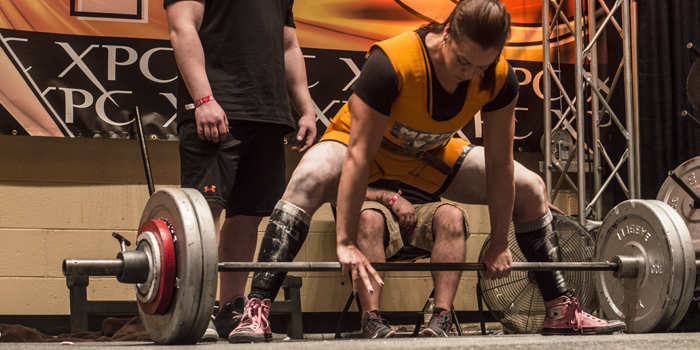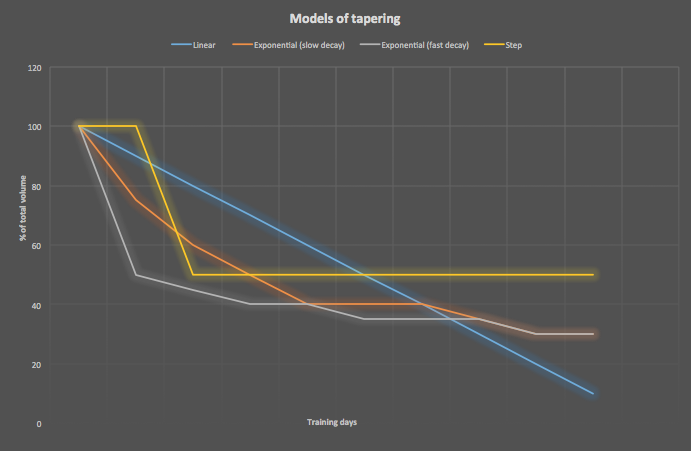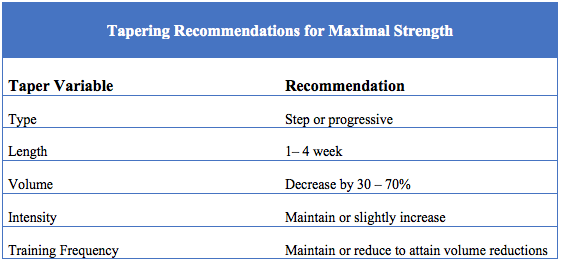
There is no better feeling for a powerlifter than to hit a PR. Especially when that PR happens in a meet and you end up winning the contest or achieving your best performance yet. We can all agree on that, right? I think we can also agree that there is no worse feeling than missing a lift and not placing your best. Well, blowing off a pec isn't the best feeling either.
So we ask ourselves, is there anything we can do to prevent poor performance in a meet? The obvious answer is that we need to train smart and intense and there is no doubt about that. But the goal of this article is to evaluate how to train and what to do in the last 1-4 weeks before the competition — in the tapering process.
What is Tapering?
If you have been training intensely with high volume for a period before the competition, we can assume you have accumulated a lot of fatigue. In order to be your best at the competition you need to reduce the total volume of work before the competition to achieve recovery and to enhance your ability to perform your best. Reduction in the workload before the competition is called tapering.
How do we define tapering? Mujika and Padilla (2000) define tapering as the last stage in a well-planned training program that has the ability to determine the success or failure of the training period prior to competition. Tapering is a reduction in the training load over a period of time which reduces the stress and fatigue of training while improving fitness to achieve optimal performance at a specific time.
WATCH: How to Design An Annual Programming for Powerlifting — Weeks 1-5 After A Meet
Le Meur et al. (2012) have determined that tapering can lead to increases in performance by an average of 3% (even though it can be as small as 0.5% or as big as 6%). 3% does not sound like much, but in powerlifting it can be a lot. If your total is 2000 pounds, that means your result in a meet can as high as 2060 pounds or as low as 1940 pounds. This can very likely move you up or down in placings.
Okay, we have determined what tapering is and how much it can contribute to performance, so the next step is to find out what can we taper and what should we taper.
What Can We Taper?
We can manipulate a few variables: volume, intensity, frequency, and the duration of tapering. The intensity of the training should increase or stay the same. One of the most important principles of training is the principle of specificity. The principle of specificity indicates that training should be very similar to the activities of the competition. In powerlifting that is simple: you lift the most you can for one rep. Your training should be very similar. That is not to say that you should max out every day, especially in the off-season, but when you come close to the meet you need to work with heavy loads as you do in the meet.
So if intensity is not reduced, what should we taper? We need to reduce the total volume. Volume is calculated as = reps x sets x weight. By reducing the number of sets you will reduce the total volume. Dropping from 10 working sets to five, we reduce the training volume. The intensity is high but the volume goes down. This will help you maintain your levels of strength and reduce overall fatigue. Frequency can also be reduced and will also contribute to overall lower volume.
How much should the volume go down? According to Pritchard et al. (2015) the volume should be reduced anywhere from 30-70% for achieving gains in maximal strength. Obviously, this is strictly individual. Someone who has trained balls to the walls for 10 weeks will probably benefit from a larger reduction in volume than someone who is training intense for four weeks.
Okay, so we need to reduce the volume, we know that. But how can we reduce the volume and in what fashion? There are a few different models of tapering.
Models of Tapering
Mujika and Padilla (2003) have stated that there are four basic models of tapering: step, linear, exponential taper with a slow decay, and exponential taper with a fast decay. In the step model of tapering, the total volume of training is reduced by a certain amount (for example 50%) and then the reduced volume is maintained for the remained time until the competition. The linear model is a model of tapering that reduces the total volume of training linearly. That can be by 5% every training session until you reduce the total volume to the wanted levels. Exponential model can be with a slow decay and with a fast decay. In both of these models the total volume is reduced by a larger amount in the beginning phase and then for the rest of the taper duration the volume is reduced by a smaller amount. The beginning reduction in volume can be bigger (for example 40%) in the fast decay model or smaller (20%) in the slow decay.
MORE: 7 Meet-Day Tactics for Putting Together Your Best Total
Which one of these models would be the best for powerlifting? According to Pritchard et al. (2015) the step model would provide the best benefits. In the step model we drop the volume by a certain amount and remain that volume until the competition. This kind of tapering will allow for the reduction of fatigue and maintaining or improving in strength. Fast decay is also a good option; the big initial drop in volume will lead to positive effects and achieving better performance. If you choose a linear model for tapering keep in mind that it is going to need to last longer, because it will take longer to reduce fatigue.
How long should the taper last? It depends on a lot of factors:
- Days of training prior to competition
- Level of the powerlifter (novice, intermediate, advanced)
- Whether or not the lifter is cutting weight for the competition
Generally, it should be anywhere between one and four weeks. If you are doing the step model you will need less days of tapering and if you are doing linear model you will need more days. Also, if you are more advanced, and are working with heavier absolute loads you will need a longer taper to reduce fatigue and improve in your preparedness.
When Should the Last Training Be?
In order to peak at a competition there is a need for cessation of training before competition. Pure logic says that if you squat heavy a day out of competition you can't expect to be your best at the meet. So you need to stop training a few days out of competition. Anderson and Cattanach (3) found small improvements in 1RM bench press and squat strength when 41 track and field athletes (22 men, 19 women) had 2-7 days off training after a five-week strength training program.
Trezis et al. (2008) found that cessation of training for four weeks after 14 weeks of training leads to decreases in 1RM in the bench press, squat and the leg press.
So we see that if the cessation of training lasts for too long it will lead to decreases in strength and if the cessation is too close to the competition the fatigue will still be there. According to Pritchard (2015) the general practice in New Zealand elite powerlifters is to cease with training for 3.7 ± 1.6 days prior to competition. Generally the last training should be anywhere from 3-5 days prior to the meet. The training cessation will depend upon the exercises. For the bench press, the cessation from training should be shorter because it is less taxing to the body and generally should be 4-5 days out. The squat should be 4-5 days out while the last heavy session should be 8-10 days out. The last deadlift should be 8-10 days out while the last heavy deadlift should be 10-14 days out.
To sum it up here is a table of recommendations from Pritchard et al. (2015):
Include these recommendations before your next meet and you can reliably expect optimal performance.
References
- Mujika I and Padilla S. (2000) Detraining: Loss of training-induced physiological and performance adaptations. Part I. Sports Med 30: 79–87,
- Le Meur Y, Hausswirth C, and Mujika I. (2012) Tapering for competition: A review. Science & Sports 27: 77-87
- Hayden Pritchard, Justin Keogh, Matthew Barnes, Michael McGuigan (2015). Effects and Mechanisms of Tapering in Maximizing Muscular Strength. Strength and conditioning journal.
- Terzis G, Stratakos G, Manta P, Georgiadis G. (2008) Throwing performance after resistance training and detraining. J Strength Cond Res. ;22(4):1198-204
- Pritchard HJ, David A Tod D, Matthew J Barnes D, Justin W K, McGuigan MR. (2015) Tapering practices of New Zealand's elite raw powerlifters. J Strength Cond Res. Dec 12.
- Anderson T and Cattanach D. (1993) Effects of three different rest periods on expression of developed strength. J Strength Cond Res 7: 185, 1993.
- Mujika I, Padilla S. Scientific bases for precompetition tapering strategies (2003). Med Sci Sports Exerc. ;35:1182–1187.
Jozo Grgić is a Master of kinesiology with high interests in sport science. He is currently working as a professor at Fitness Academy in Zagreb, Croatia. He is also a Fitness index certified operator and an ACSM certified personal trainer.












Bob